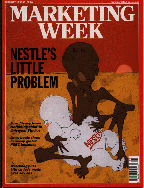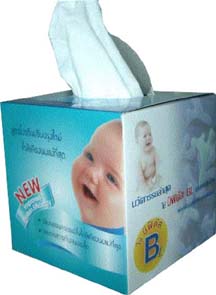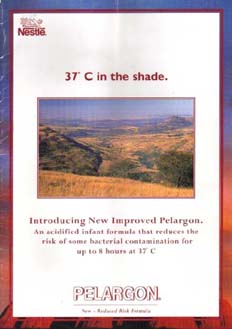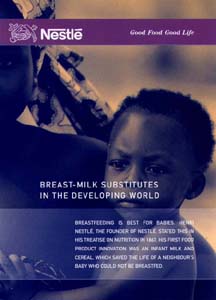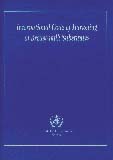Nestlé's public
relation machine exposed
This paper gives
an overview of the campaign against Nestlé and responds
to arguments Nestlé has used in the recent past in letters,
booklets and briefings.
Also see the Your
Questions Answered page and Boycott
News and the previous version
of this briefing
If you have had
any other arguments put to you by Nestlé staff or have
any questions of your own, please contact us for further information.
Contents
Last
update 21 April 2005
Nestlé
spends a fortune trying to divert criticism of its baby food marketing,
but does it tell the truth?
| Nestlé
has a serious image problem because of its on-going aggressive
marketing of baby foods. Instead of making changes required
to bring its practices fully into line with international
marketing standards, Nestlé invests heavily in Public
Relations (PR) initiatives intended to divert criticism. But
Nestlé makes demonstrably untrue claims which have
resulted in further damaging publicity, such as the cover
shown right. |
|
Nestlé is singled out for boycott action because independent
monitoring conducted by the International Baby Food Action Network
(IBFAN)
finds it to be the largest single source of violations of the
World Health Organisation’s (WHO) International
Code of Marketing of Breastmilk Substitutes and subsequent,
relevant World Health Assembly Resolutions worldwide. Nestlé
also takes the lead in attempting to undermine implementation of these measures by
governments (some
examples listed here - needs updating).
According to UNICEF:
"Marketing
practices that undermine breastfeeding are potentially hazardous
wherever they are pursued: in the developing world, WHO estimates
that some 1.5 million children die each year because they are
not adequately breastfed. These facts are not in dispute."
(Click
here for further details).
The introduction of
the International Code in 1981 should have ended the malpractice,
but companies continue to violate it today.
An increasing number
of governments have introduced legislation implementing the provisions
of the International Code and Resolutions (click
here for the International Code Documentation Centre's State
of the Code by Country chart - 1.5 Mbytes). Nestlé pushes
for unenforceable voluntary codes in place of laws. It even took
legal action against the Indian Government in an attempt to have
the law there revoked after the company was taken to court for
not putting warning notices in Hindi on labels (see the IBFAN
report Using
international tools to stop corporate malpractice - does it work?
for case studies of countries where implementation of the Code
and Resolutions is working and where they have been undermined).
Part of Nestlé’s
PR strategy sometimes includes claiming health campaigners are
trying to ban the sale of breastmilk substitutes. This is totally
untrue. The aim is to ensure breastmilk substitutes are marketed
appropriately. Other bogus Nestlé’s claims are exposed
below. Our position on Nestlé arises from the evidence
of malpractice. We are seeking to protect infant health and mothers’
rights. Nestlé’s claims do not stand up to scrutiny.
When the UK Advertising Standards Authority (ASA) conducted a
two-year investigation into claims Nestlé made in an anti-boycott
advertisement, it found they could not be substantiated. Nestlé was warned
by the ASA not to repeat the claims. Yet it continues to make
similar claims in public relations materials which are not subject
to the same regulations as advertisements (click
here for details of the complaints and here
for the final ruling and here
for the Chief Executive's response).
Nestlé’s
bogus arguments exposed
Nestlé
says: The problems with the marketing of breastmilk substitutes
were resolved long ago.
The facts: IBFAN’s
latest monitoring report Breaking
the Rules, Stretching the Rules 2004 documents violations
of the International Code and Resolutions gathered in 69 countries.
As in past monitoring exercises, Nestlé was found to be
the source of more violations than any other company. This is
why it is singled out for boycott action.
|
Nestlé’s
strategy is to admit to malpractice only years in the past,
even though it denied it at the time.
When the exposé
The Baby Killer was published in 1975, Nestlé denied
any wrong-doing. It even sued campaigners in Switzerland
who translated it into German, but had to drop nearly all
charges as experts trouped into court to provide substantiation.
Nestlé
only won against the title in German, which was ‘Nestlé
kills babies’ on the grounds it wasn’t committing
deliberate murder.
The Judge awarded
token fines and warned Nestlé to change.
|
|
Today Nestlé
admits to malpractice in the 1960s and 1970s, though it hasn’t
apologised to the families who lost infants during this period
or offered any form of compensation.
In 1999 the UK Advertising
Standards Authority ruled against Nestlé’s claim in
an anti-boycott advertisement that it did not distribute free
supplies of infant formula. Today Nestlé claims it used
to do so, but stopped in the 1990s.
Malpractice it denies
today, will likely be admitted in a few years time. But Nestlé
will say: “That was a long time ago. We have changed.”
Nestlé
says: So-called violations are not for infant formula, but
complementary foods that are not covered by the Code.
|
The facts:
IBFAN’s Breaking
the Rules monitoring report separately details violations
relating to formulas and those relating to complementary
foods.
A favoured tactic
is promotion through the health care system. This makes
it seem as if Nestlé has the endorsement of health workers. The tissue box on the
right is in the style of Nestlé’s Nan
formula labels and was distributed to health workers in
Thailand.
|
|
| Companies
are permitted to provide ‘scientific and factual’
information to health workers, but the materials Nestlé
produces on its formulas are misleading and promotional. For
example, a leaflet on Lactogen 1 claimed the formula is good
for ‘brain, body and bones’ and was dominated by
bright pictures rather than scientific information. |
|
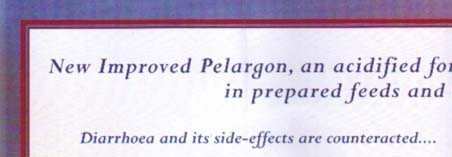
|
In Botswana Nestlé
has distributed a pamphlet for Pelargon infant formula
which claims that with the formula ‘diarrhoea and
its side-effects are counteracted’ (right and above
- click
for full image).
This is highly
misleading as it implies the formula can be used to treat
diarrhoea, but infants fed on Pelargon are at greater
risk of becoming ill and possibly dying as a result of diarrhoea
than breastfed infants.
|
|
|
The World Health
Assembly has also adopted Resolutions relating to complementary
foods. For example, Resolution
49.15 calls for action "to ensure that complementary
foods are not marketed for or used in ways that undermine
exclusive and sustained breast-feeding."
Despite this,
Nestlé promotes products such as whole milks alongside
more expensive infant formula in the infant feeding sections
of supermarkets and pharmacies (click
here for evidence). Nestlé has even produced
promotional materials such as the calendar from the Dominican
Republic on the right, which shows Nido whole milk
in a feeding bottle.
Nestlé
refuses to stop these practices even though it knows poor
mothers who have decided or been persuaded not to breastfeed
often use powdered whole milk instead of infant formula.
|
|
Nestlé
says: Isolated violations may occur because Nestlé
is a big company. Campaigners do not provide information to allow investigations.
|
The facts:
Nestlé’s own internal instructions permit violations
of the International Code and Resolutions.
The analysis
below shows some of the ways they fall short. UNICEF raised
some of these issues with Nestlé’s Chief Executive
Officer, Peter Brabeck-Letmathé in a letter in November
1997 - yet he still hasn’t brought Nestlé’s
policies into line.
Monitoring demonstrates
violations are ‘systematic’. This description
was used first not by IBFAN, but by the Inter-agency Group
on Breastfeeding Monitoring (IGBM) in its 1997 report Cracking
the Code. Then, as today, Nestlé denied any wrong-doing.
|
|
IBFAN conducts monitoring
to determine if companies are fulfilling their obligations, not
to provide a service to Nestlé.
|
The International
Code (Article
11.3) is quite clear:
“Independently
of any other measures taken for implementation of this
Code, manufacturers and distributors of products within
the scope of this Code should regard themselves as responsible
for monitoring their marketing practices according to
the principles and aim of this Code, and for taking steps
to ensure that their conduct at every level conforms to
them.”
|
|
IBFAN groups report
violations to government enforcement authorities as an on-going
activity. Many of the violations in the Breaking
the Rules report had been raised with national Nestlé
offices before it was published. Why then does Nestlé claim
it was unaware of them? Nevertheless, IBFAN provided a detailed list of where the company’s promotions had been
found to Nestlé head office when asked to do so. Nestlé
did not respond to indicate it was taking any action.
What of Mr. Brabeck’s
promise that he personally investigates any hint of a violation?
Nestlé claims
to have instigated an 'ombudsman' system, but Baby Milk Action
has written to the ombudsman asking for the violations on which
Mr. Brabeck has failed to act to be investigated and has received
no reply (click here for
details).
Nestlé
Instructions and the International Code and Resolutions. Where
do they differ?
|
The International
Code Documentation Centre (ICDC) trains policy makers on
implementing the Code and Resolutions on courses supported
by WHO and UNICEF.
ICDC’s legal
expert has compared the Nestlé Instructions (on implementing
the Code) to the provisions of the International Code and
Resolutions, and has found a dozen examples of how the company
misrepresents them to justify continued promotion (click
here for the full analysis - pdf).
The flawed Nestlé
Instructions are used by the auditors Nestlé commissions
to verify its activities (such as Bureau Veritas) rather
than the Code and Resolutions. Independent monitoring finds
violations of Nestlé weak Instructions.
|
|
|
International
Code and Resolutions
|
Nestlé
Instructions
|
| 1.
Applies to all countries as a minimum standard. |
1.
Apply to a list of developing countries of Nestlé’s
own invention. |
| 2.
Applies to all breastmilk substitutes, including other milk
products, foods and beverages marketed to replace breastmilk. |
2.
Apply only to infant formula and to those follow-up formula
with the same brand name. |
| 3.
No idealising pictures or text in any educational materials. |
3.
Allow for baby pictures “to enhance educational value
of information”. |
| 4.
No promotion to the public or in the health care system, direct
or indirect. |
4.
Allow for company “Mother Books” and “Posters”
with corporate logo to be distributed or displayed by health
workers. |
| 5.
Educational material with corporate logos may only be produced
in response to a request by government and must be approved.
No product names allowed. |
5.
Allow educational materials with corporate logos for use by
health workers in teaching mothers about formula. |
| 6.
No donation of free formula or other breastmilk substitutes
to any part of health care system. |
6.
Allow for free formula if requested in writing by health workers. |
| 7.
There should be no display of brand names, or other names
or logos closely associated with breastmilk substitutes, in
the health care system. |
7.
Allow for wristbands, feeding bottles, health cards etc. with
corporate logo. |
| 8.
Promotion of breastfeeding is the responsibility of health
workers who may not accept financial or material inducements
as this may give rise to conflict of interests. |
8.
Allow for “general” videos, brochures, posters,
breastfeeding booklets, growth charts, etc. No brands but
corporate logo allowed. |
| 9.
Samples only allowed if necessary for professional evaluation
and research. |
9.
Allow samples to introduce new formulas, new formulations
and samples for new doctors. |
| 10.
Sponsorship contributions to health workers must be disclosed. |
10.
On a case by case basis, financial support is allowed (does
not mention disclosure). |
| 11.
Labels must follow preset standards. WHO does not vet or approve
labels. |
11.
Nestlé claims its labels were developed in consultation
with WHO. |
| 12.
It is for governments to implement national measures. Independently
of these, companies are required to ensure compliance with
the International Code at every level of their business. |
12.
Nestlé Market Managers should “encourage”
introduction of national codes [voluntary unenforceable codes
rather than laws]. |
Small victories:
In 1994 the World Health Assembly stated that complementary feeding
should be ‘fostered from about 6 months’ (click
here for Resolution 47.5). It took 9 years of letter writing,
media work, demonstrations and further World Health Assembly Resolutions
before Nestlé said it would change the labels of its complementary
foods to comply (see the codewatch
section for past campaigns and Nestlé responses).
19 years after the
Code, following a television
exposé, Nestlé said it would endeavour to label
products in the correct language.
Time
for a tribunal
Nestlé’s
claims do not stand up to scrutiny and it dislikes having its
case challenged.
Debates
The company used to
refuse to speak in public meetings if IBFAN members were present.
This changed in 2001 thanks to pressure from the boycott and Nestlé
has taken part in a number of debates with Baby Milk Action in
the UK. Nestlé boasts about its openness to face its critics
in a new leaflet (pictured above), but fails
to mention two things.
Firstly, it continues
in its attempts to speak without Baby Milk Action being present.
Secondly, it does not
acknowledge that it has lost every debate as its claims do not
stand up to the documentary evidence of its own promotional materials
(click
here for a debate report).
European Parliament
The European Parliament
held a public hearing into Nestlé malpractice in November
2000. The IBFAN group from Pakistan, the Network for Consumer
Protection, presented evidence of malpractice. UNICEF’s Legal
Officer was present to respond to any questions regarding interpretation
of the marketing requirements. Nestlé was invited to present
evidence on its marketing policies and practices, but it objected
to the presence of IBFAN and UNICEF and refused to attend. Instead
it sent someone who had been paid to conduct an audit of Nestlé’s
activities in Pakistan. The auditor was unable to respond when UNICEF pointed out that Nestlé’s
Instructions used for the audit are not the same as the Code and
Resolutions (click
here for full details).
Nestlé rejects
public tribunal
Boycott coordinators
have put a plan to Nestlé for ending the boycott (see
Boycott News 29).
The first point requires Nestlé to accept the World Health
Assembly position that the Code and Resolutions are minimum requirements for all countries. Nestlé refuses
to do so.
Campaigners cannot
re-negotiate the marketing requirements with Nestlé - it
is the responsibility of the World Health Assembly to review progress
and address new issues and questions of interpretation. However,
campaigners are calling for Nestlé to attend a public tribunal,
where Nestlé and health experts can present evidence to
an independent panel.
The purpose of the
tribunal is to evaluate who is telling the truth. Nestlé
has rejected this proposal. Individuals and organisations are encouraged to write to Nestlé
asking it to agree to the public tribunal. Write to:
Peter Brabeck-Letmathé
Chief Executive
Nestlé S.A.
Vevey, Switzerland.
Or send a message via
http://www.nestle.com/
A
history of PR disasters
|
Nestlé’s
Chief Executive Officer, Peter Brabeck-Letmathé,
(right) claims that he personally investigates any hint
of a violation of the baby food marketing requirements.
As the man personally responsible he often over-reacts to
criticism of the company, causing Nestlé more problems.
For example,
when the UK Advertising Standards Authority effectively
branded Nestlé ‘a liar ’ (as the marketing
press put it) for claiming to market baby milk ethically,
Mr. Brabeck held a press conference in London and lambasted
company critics, including the Director General of UNICEF.
Stunned journalists then ran headlines such as ‘Mr.
Nestlé gets angry’ (Independent on Sunday,
9th May 1999).
|
|
A more costly example
is when Mr. Brabeck wrote to critics and policy makers around
the world with a hard-bound book containing letters which he claimed
were “official government verification that Nestlé abides by the Code”. Those who read through the 54 letters
found many were no such thing. The company had to apologise as
some of the authors complained their letters had been misrepresented
and used without permission (click
here for further details).
How
you can help
Nestlé spends
as much on marketing and PR in 15 minutes as Baby Milk Action
runs on for a year. We constantly struggle to raise funds to keep
operating. Our small number of staff frequently have to reduce
their hours when funds are short. Can you help to keep us running
by sending a donation, becoming a member or purchasing Baby Milk
Action merchandise? Please
visit the on-line Virtual Shop.
To send letters calling
on Nestlé and other companies to stop malpractice see the
codewatch section. You can
also send messages of support to governments when Nestlé
is lobbying to weaken legislation.
Sign
up to support the boycott. Petitions are presented to Nestlé
from time-to-time. The boycott
section contains suggestions for action.
|



